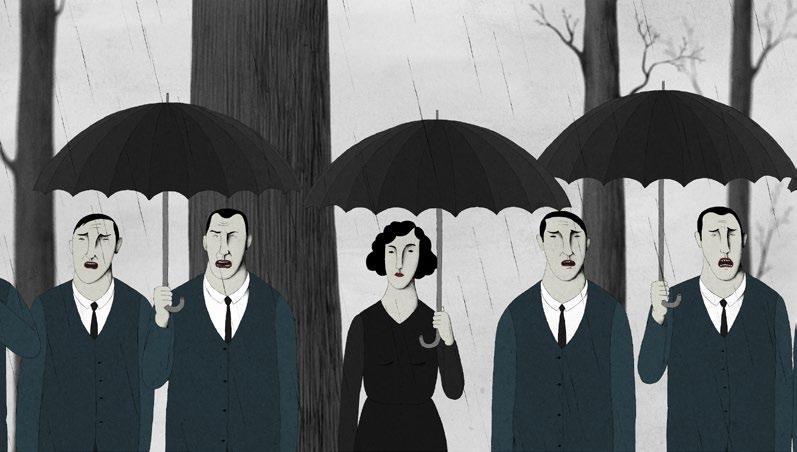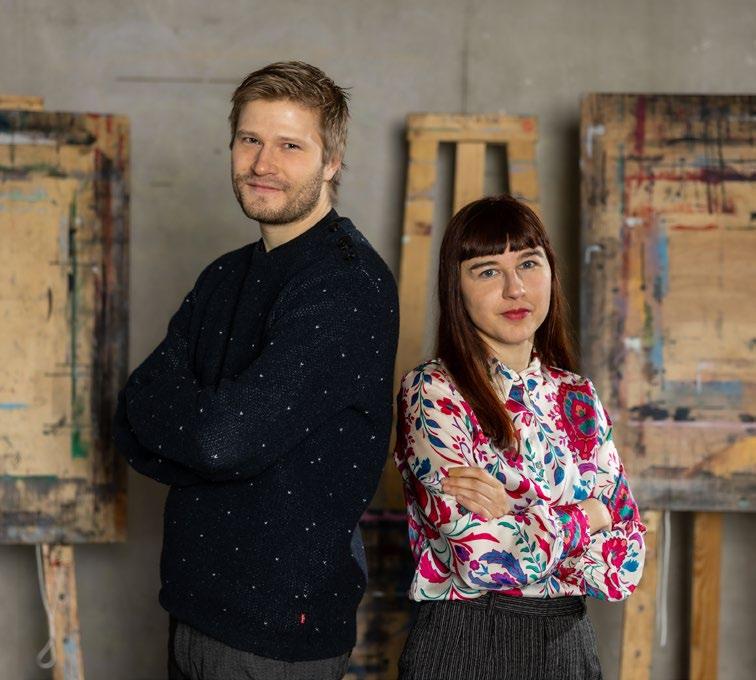
4 minute read
A BEAUTIFUL Estonian Widow IN BERLIN
Peep Pedmanson interviewed screenwriter-director Morten Tšinakov about the making of animation film Eva, to be premiered in the Berlin International Film Festival 2023.
By Peep Pedmanson Photos by Erlend Štaub
Eva is the story of a widow whom a group of ordinary men tries to console; however, the woman won’t cope with her grief, loses self-control, and confuses reality and dreams. She feels guilty about her husband’s death, and this burden is heavy and makes things even worse until the inevitable tragic end. This is already the third film for filmmakers Morten Tšinakov and Lucija Mrzljak, Morten being the screenwriter and Lucija the film artist. It is not hard to notice that both the screenplay and the design are remarkably excellent in style in Eva.
Morten, screenplays often change during the working process, and some authors claim that animation comes alive only when the filming starts. As for Eva, the initial screenplay turned out to be the final film almost 100%. How did you manage to do that?
I am rather a slow writer and it may take a year or year and a half until the final version. I collect ideas and then get rid of some of them. One moment, an incomplete story emerges out of these ideas. This is when I start writing and fill the gaps with something that comes into my mind. And several drafts will be written
Eva
which takes quite a long time, and hopefully only the best ideas will prevail. To change things later during filming doesn’t obviously seem the best idea for me, it can be rather dangerous since you can confuse your timeline between getting the initial idea and understanding whether the idea works or not.
Certainly, you’ll finally get a bit tired when for year and a half you keep doing the same thing. And yet, when spontaneously changing things the possibility to mess something up is much bigger than to make it better. And with Eva we really made very few changes. We decided to cut off one lengthy segment in the film as it slowed everything down too much.
When is the right moment when you realise that the screenplay is ready and filming can start?
With every screenplay it somehow happens that whatever you do then some scenes always seem to be not so good compared to others. And I don’t know why is that so. And at the same time, the story won’t work without these scenes, so one has to put up with them. We certainly try to iron out the weak points, but it is impossible to get rid of these completely. At some point, you have to decide that it’s ready and good enough, otherwise you will go on with writing forever.
You are both young, yet your films are expressing a resignation based on life’s experience, accompanied by sad, dark humour. These cannot be personal experience of yours? As an author, do you rather work with archetypes relating to a specific era?
When I am writing stories then I try to avoid being focused on a specific “theme” for as long as possible, otherwise I would lose a lot of interesting ideas that won’t fit into one specific frame. I like to invent various sketches and scenes, even the seemingly idiotic and somewhat absurd ones, and later combine these. Some ideas may be taken from personal experience, others are inspired by some sentence I have encountered in a book, and the rest may come from who knows where. For instance, a scene that came to me in a dream later became the basis for Eva, and was filmed exactly the way I saw it. The rest of the film started to develop around the scene. I cannot exactly say why these ideas usually come in such dark colours. Perhaps hopeless stories seem much deeper to me than happy ones.
There are other authors’ couples in the field of animation, but it is not really very common. How do you divide your tasks with Lucija when working as a team?

It has been the way that I have been busy with writing the story, and when it’s ready then we’ll move on with it together. During writing it also happens that I ask Lucija’s opinion whether one or another thing works or not. Since I have poor drawing skills, then Lucija takes care of everything related to design –and this is especially so in the last film. She designed both the characters and the backgrounds in Eva, and I was responsible for colours, textures, and post-production (shadows, focuses, etc.). When the screenplay is ready then we start working with the storyboard. We sit down with the screenplay and start discussing where the camera perspective should be in every scene, how characters should move, etc. Then we create layouts, and the rest will be on the shoulders of the professional animators and drawers of the animation studio.
Estonian Animations in Berlin
Estonia will be represented by two animation films at the Berlin Film Festival 2023. One of them is the 16-minute-long Eva directed by Morten Tšinakov and Lucija Mrzljak, produced by Eesti Joonisfilm (Estonia), and co-produced by Adriatic Animation (Croatia). And the other one is a full-length Luxembourg animation
A Greyhound of a Girl (directed by Enzo D’Alò), where Estonia has been a minority co-producer together with Italy, Ireland, the UK, and Latvia. Whereas the Greyhound is clearly a film for all audiences, then Eva is an excellent example of Estonian art-house animation characterised by high-quality visual design, strong artist’s statement and narrative, and it has had a remarkable success in film festivals.
How long do you usually work to complete a 15-minute-long animation?
It depends on what kind of work is included in the process of filmmaking. The production phase of our films lasts for about year and a half. But this is preceded by the development of the initial idea and working with the screenplay that altogether lasts for four to six years. There are certainly filmmakers who work faster or slower than me.
How do you perceive the meaning and the role of state-funded festival-animation in Estonian culture? Perhaps some culture theorist should be asked this question. I have never had any answers to such questions. If the result has something to do with human values and the film offers solutions within the chaos, then perhaps this is the meaning. And that’s why it is also important, whether it be an animation, a feature film, a documentary, music, literature, or anything else. We are both intrigued and influenced by the genre of animation film, this is our way to communicate with the world. And I am happy that for this we have the professional field and the state support. We try to make our work as professionally as possible so that it would bring joy also for others and not only ourselves. BF










